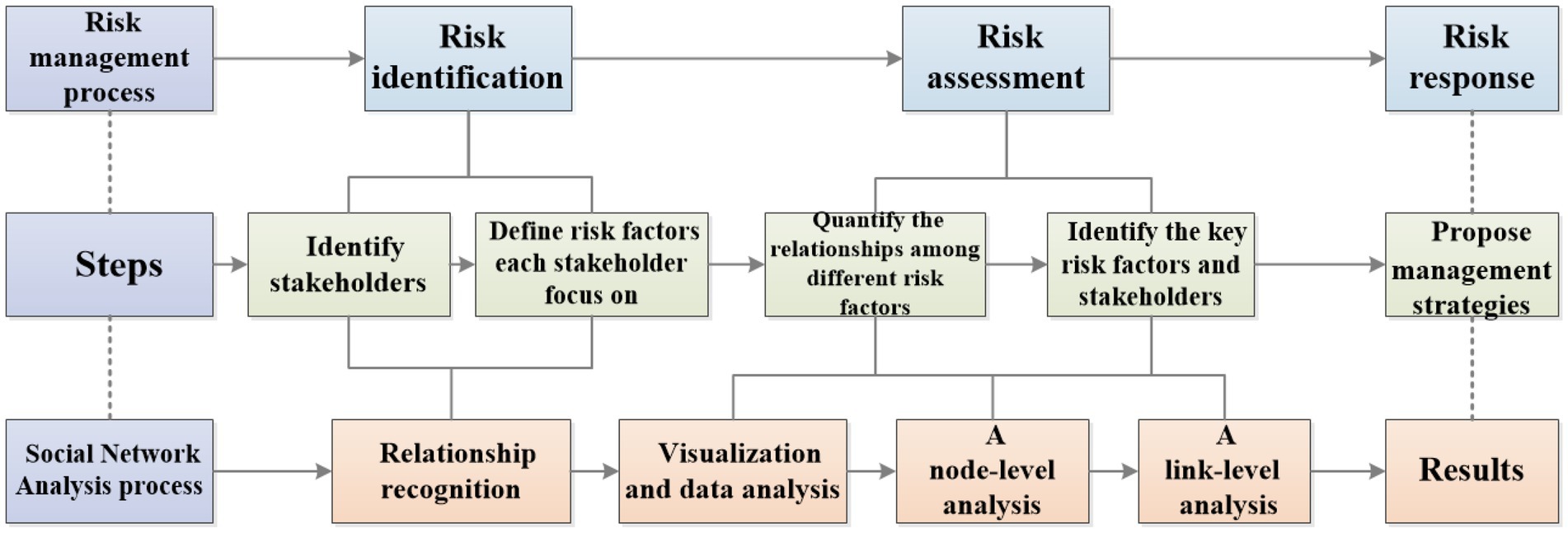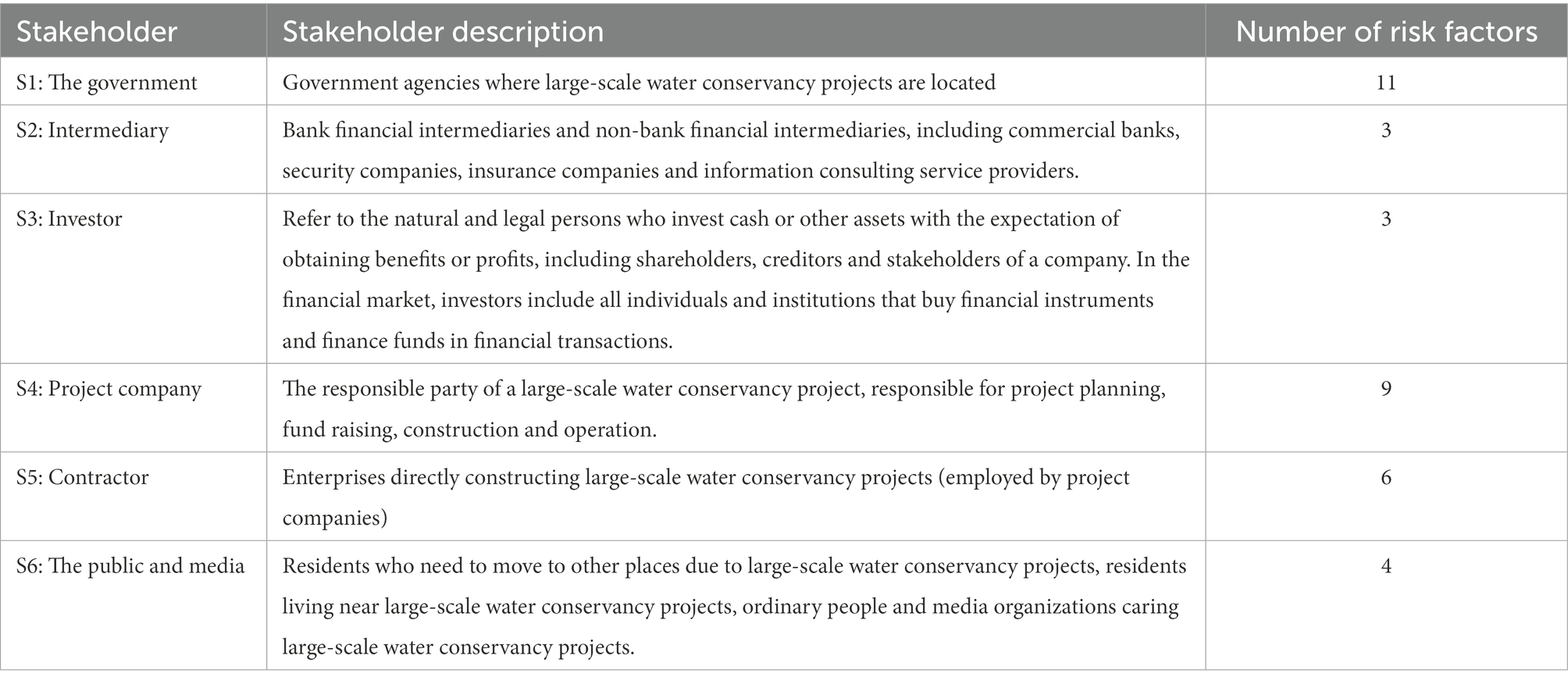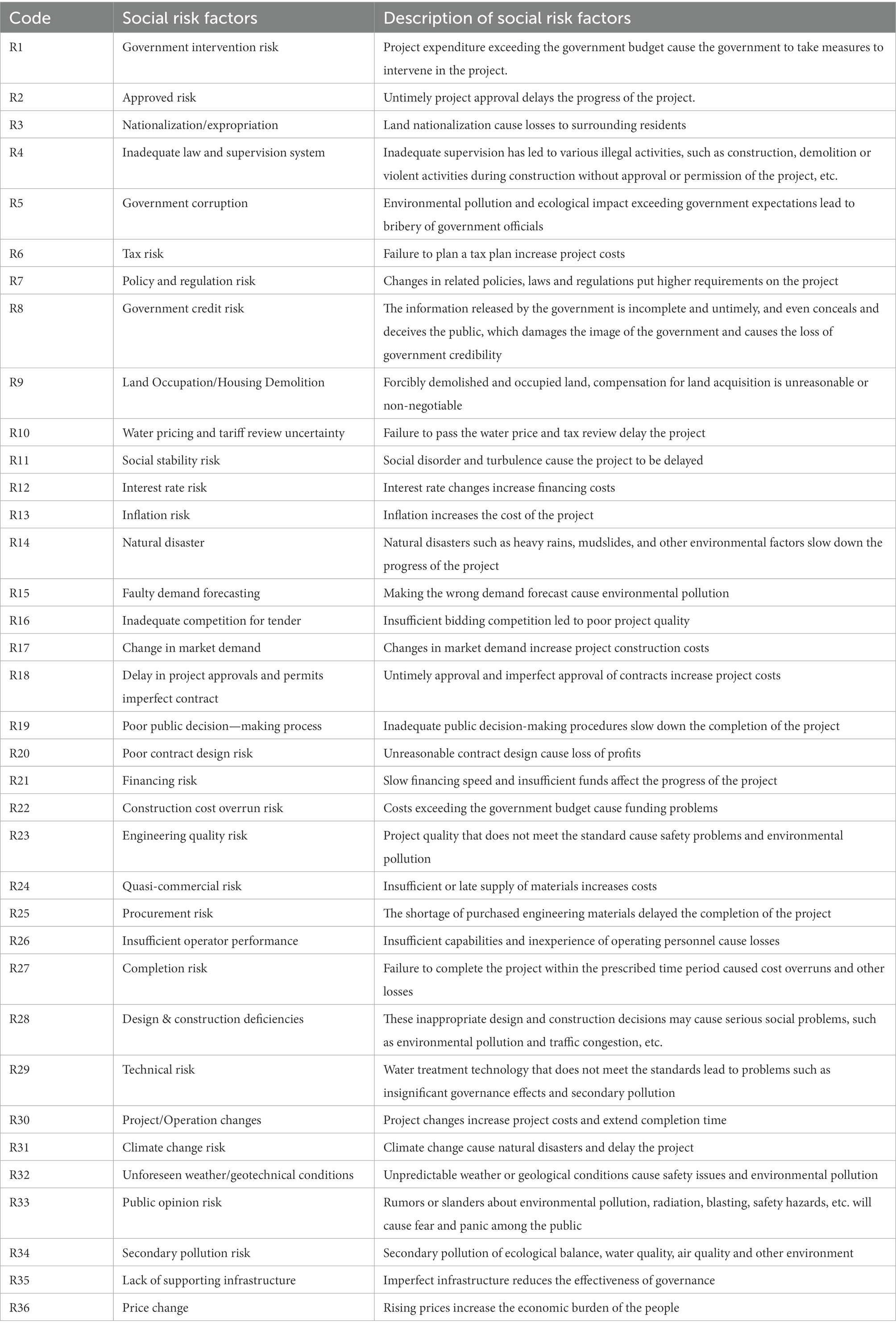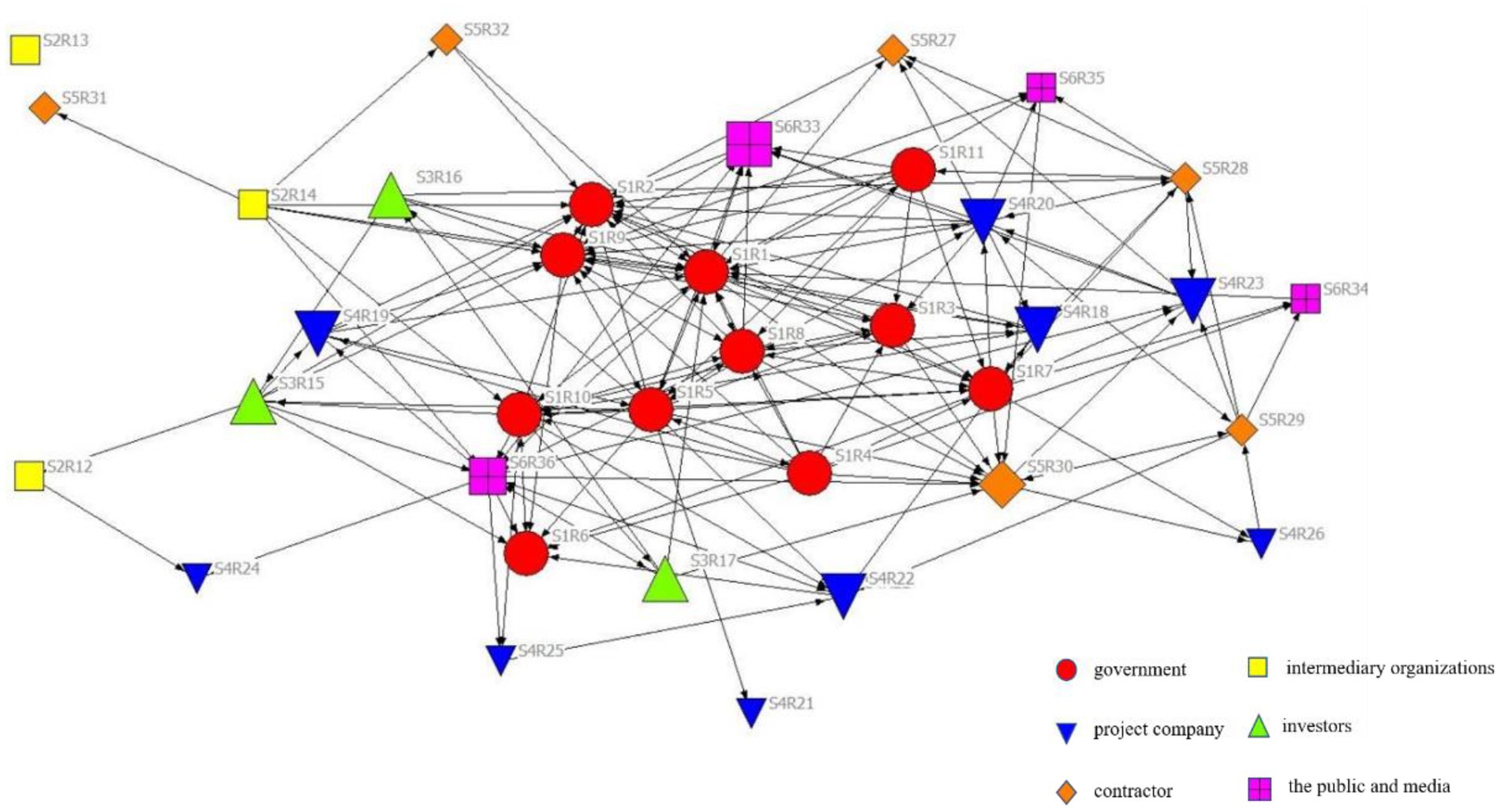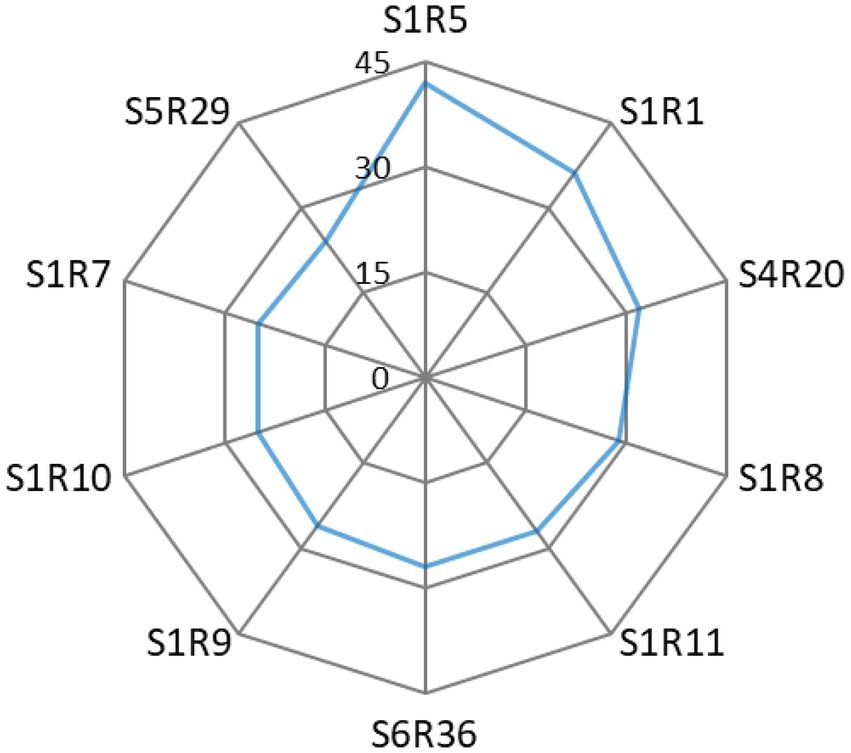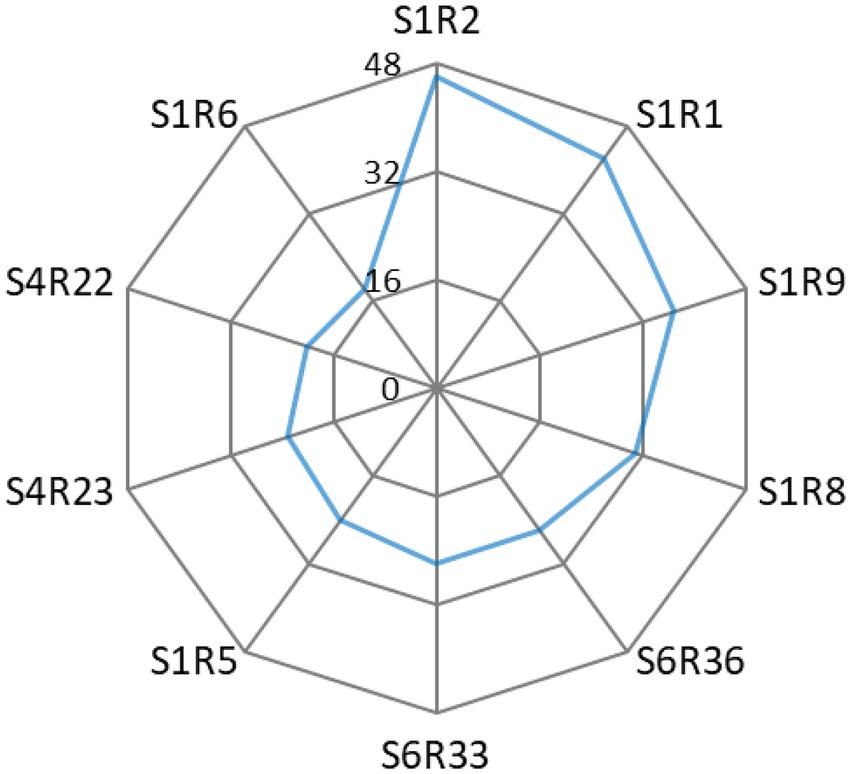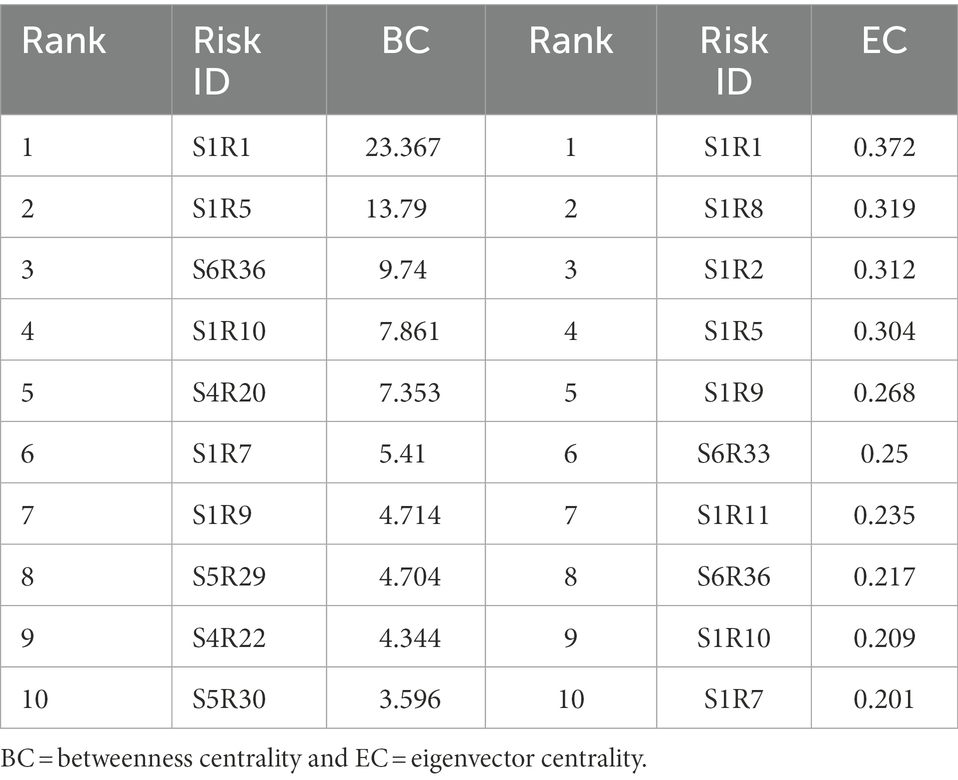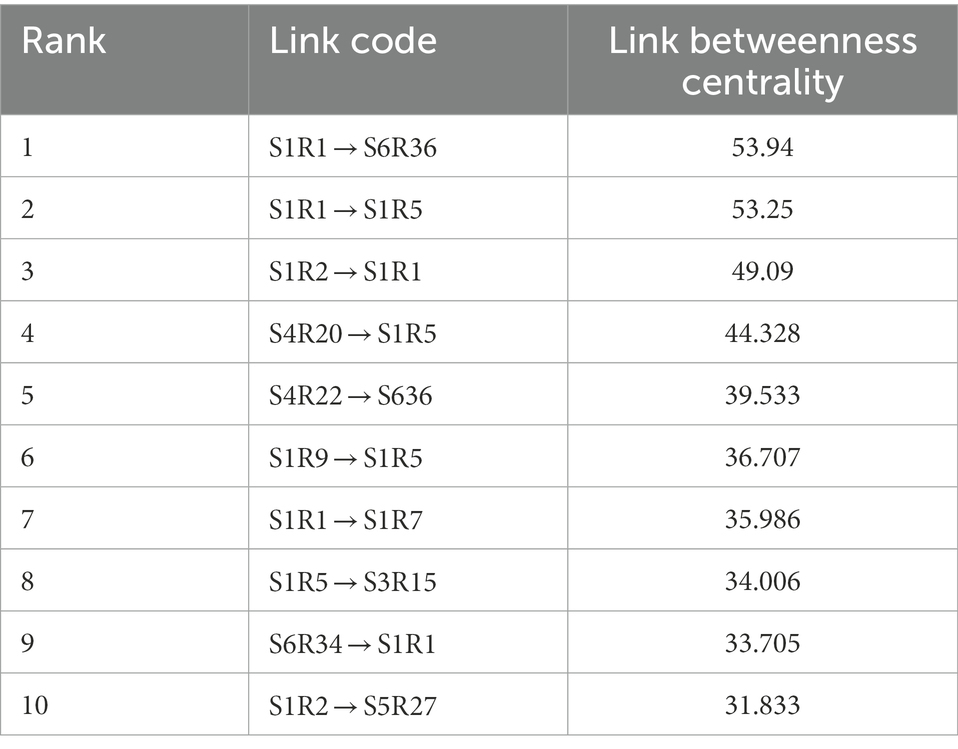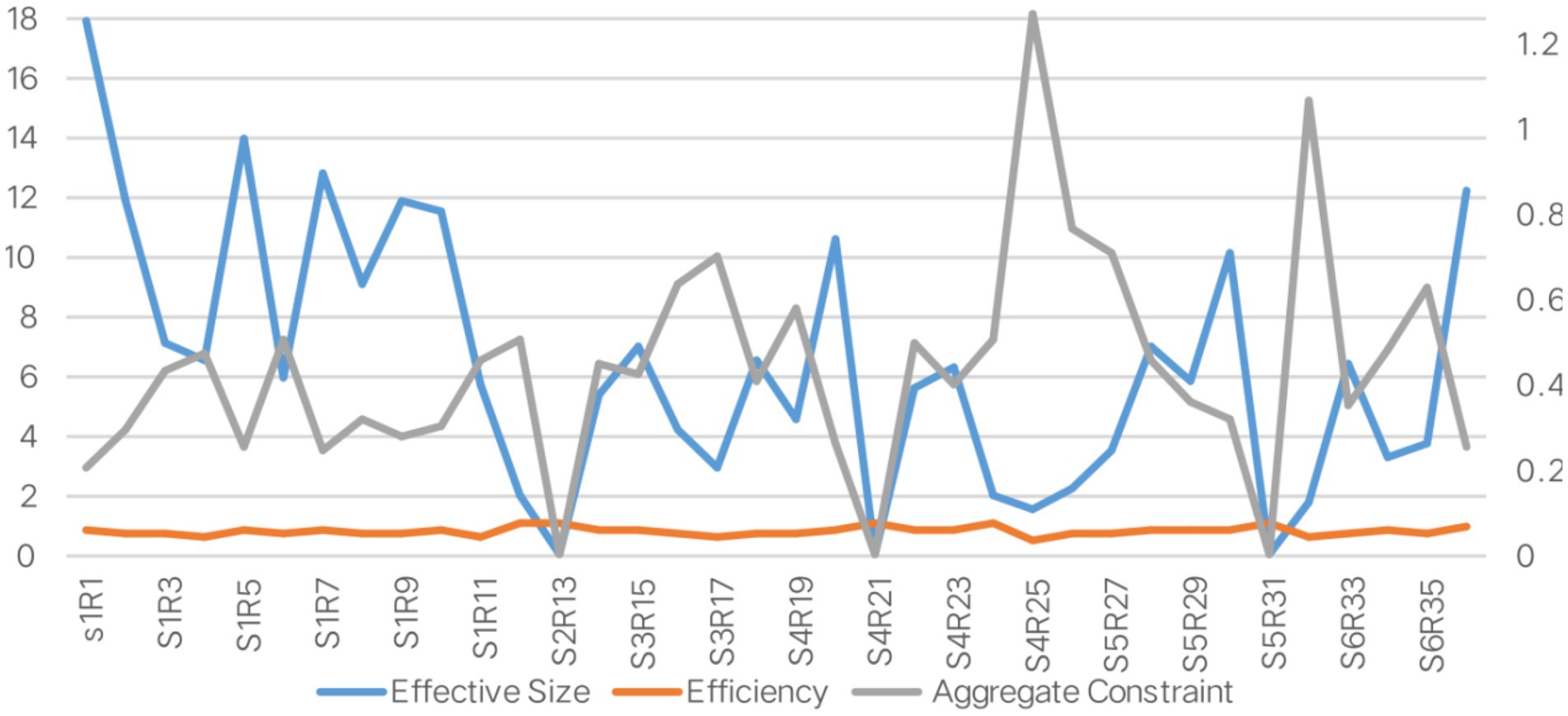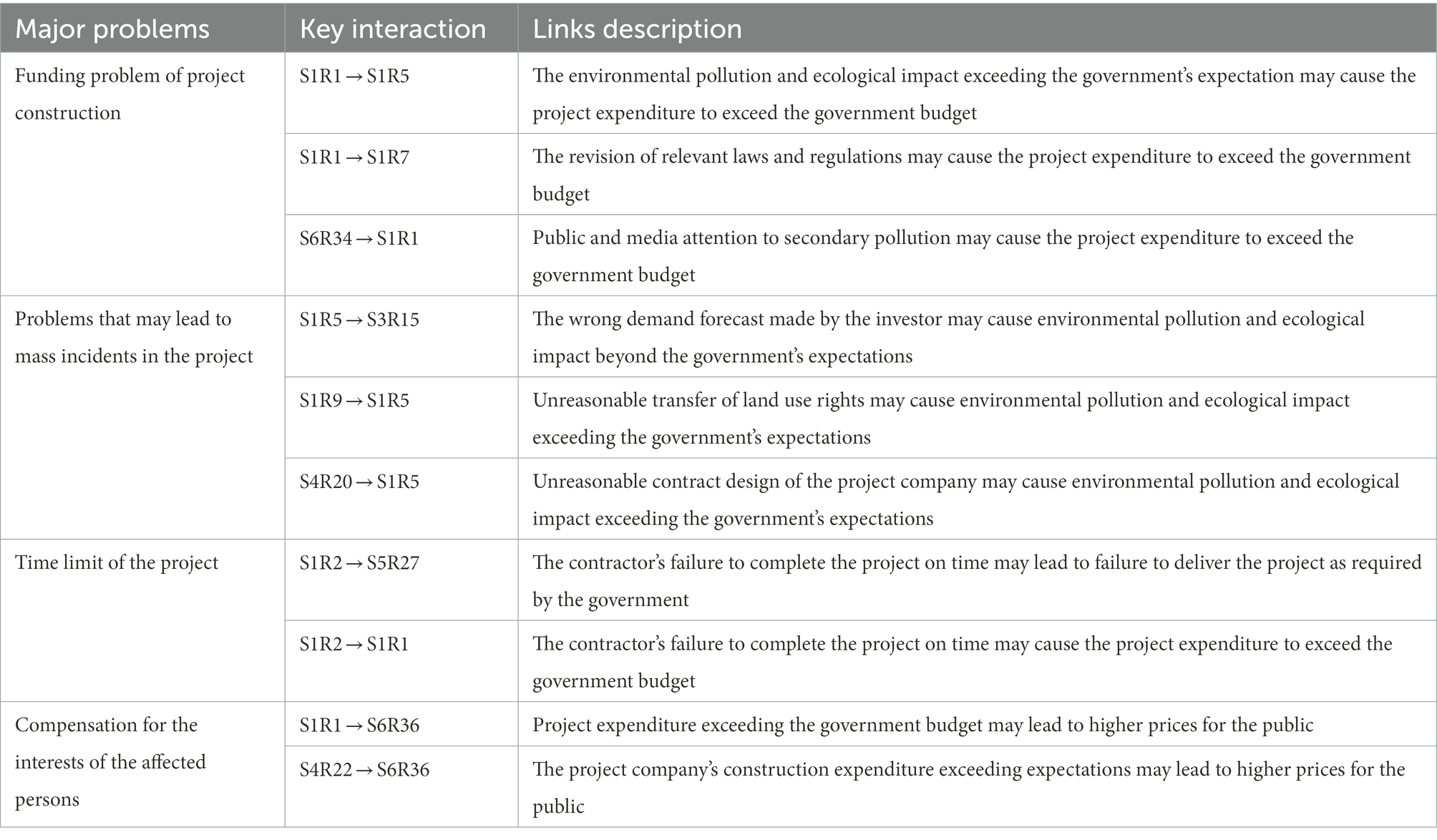- 1Business School, Sichuan Normal University, Chengdu, China
- 2Business School, Sichuan University, Chengdu, China
- 3Sichuan Provincial Key Laboratory of Sci-Tech Finance and Mathematical Finance, Sichuan University, Chengdu, China
The pluralism of stakeholders in PPP project for water environmental governance and the complex interrelationship among stakeholders are the important factors affecting social stability risk. Previous studies have mainly focused on risk identification and assessment. We aim to investigate the key social risks of PPP project for water environmental governance, to understand which social risks stakeholders are concerned about, and what interactions they follow. First, relevant risks and their interrelationships were investigated through a literature review and interviews. Second, the key social stability risks were identified based on social network analysis. Third, strategies were proposed to mitigate the social stability risks. The results show that government corruption, government intervention risk, approved risk, poor contract design risk price change and policy and regulation risk are the key risks with the highest in/out-degree, centrality and ego network size. Four core stakeholder groups (i.e., government, contractors, project companies, and the public and the media) and four core challenges (i.e., difficulties in financing, lack of mass incidents prevention mechanism, incomplete project schedule control system and improper handling of benefit compensation issues) have intensive relationships. We concluded that controlling the complicated relationships among four core stakeholder groups can reduce the social stability risks. The social network analysis framework combining stakeholder management and risk management provides a reference for the management of PPP projects for water environmental governance.
1. Introduction
As an important task to protect the ecological environment and promote the national economy, water environmental governance has attracted great attention from the government and society (Xue and Wang, 2020), and the Public-Private Partnerships (PPP) water governance is widely used (Li et al., 2019). On the one hand, the comprehensive water environmental governance projects under the PPP mode can introduce social capital and relieve the government’s financial pressure; on the other hand, such projects can improve governance efficiency and give play to the professional technical level of social capital in water environment problems and its relative advantages of operation and management (Xue and Wang, 2020). However, after years of engineering practice, these projects have also revealed some problems. Under the current model, the situation of “emphasizing construction and neglecting supervision” is prominent, lacking effective management and overall coordination. Mechanisms, there has been a trend of low project returns and the gradual mechanization of governance standards (Xu et al., 2010). This trend may cause some problems, such as damage to public interests (Effah Ameyaw and Chan, 2013; Li et al., 2020), low-quality water supply service, ecological safety problems (Li et al., 2020), tremendous project cost (Xue and Wang, 2020), sewage not fully treated (Xue and Wang, 2020), and long project period (An et al., 2018). Thus, in the recent development of the PPP project for water environmental governance, the conflicts between stakeholders have become more prominent, which will eventually cause social risks and have an extremely negative impact on these projects.
The research aims to explore key risk factors for social stability and their connections in PPP project for water environmental governance, and to find out the stakeholders who are concerned about these risks. The questions include: what risk factors play a key role, what are the connections between them, and who are the stakeholders concerned about these risks? Traditionally, these problems are solved through separate stakeholder analysis and social stability risk analysis (Yang et al., 2011). Given the complexity of such projects, they often involve many stakeholders such as the government, project companies, the public, and the media (Li et al., 2020). Social risks are not only closely associated with construction personnel working in such projects, but also closely related to other stakeholders (Grünebaum and Bode, 2004). He et al. (2018) and Wang et al. (2020) proposed a stakeholder-associated risk analysis (SNA-SARA) based on social network analysis (SNA) to analyze project risk factors. The main reason for these social risks is the complexity and uncertainty of PPP project for water environmental governance, which leads to complex relationships among various departments and conflicts between stakeholders (Li et al., 2020). Therefore, in China and even in the world, the social risks of PPP project for water environmental governance are getting more and more attention. The focus of the attention concerns the identification, evaluation and management of social risks (Ait-Mouheb et al., 2018; Li et al., 2019). In China, social risks are playing an increasingly significant role in project success, which poses a challenge to the social consequences of PPP projects for water environment governance under the influence of different stakeholders (Xue and Wang, 2020). However, there are few studies on the social risks of these projects, of which characteristics are different from those traditional risks (for example, cost overruns and quality issues). Such social risks are closely associated with stakeholders and are oriented to large-scale groups and highly dynamic processes (Yuan et al., 2018). Conventional risk analysis, including risk identification and assessment on the basis of systems engineering viewpoints, cannot be fully applied to identify issues associated with social risks (Yang and Zou, 2014; Yuan et al., 2018).
We combine classic qualitative stakeholder and social stability risk analysis based on interviews and literature reviews with more quantitative and rigorous social network analysis through investigations, so as to improve the SNA method and promote the social stability risk management of PPP project for water environmental governance. The complex relationship between different stakeholders is the main reason for social risks. Therefore, we hope to identify relevant stakeholders in detail, analyze the relationship between these stakeholders, and identify potential social risks to solve the above research problems in this paper. In terms of methods, we hope that by improving traditional social network analysis, we can combine stakeholders and social stability risks to analyze the links between them (by improving traditional social network analysis), so as to overcome the shortcomings of traditional methods. Although the results of this study have certain limitations, our results can prompt stakeholders to take effective measures to reduce project risks, and provide a framework for targeted prevention and response to social stability risks.
The following section describes the theoretical background, including research on social stability risk management and stakeholders of water environment governance projects and social network analysis theory and its applications. The research methodology is explained. This is followed by the analysis results at the analysis of network level, node level and link level. The paper is concluded with a discussion and the conclusions.
2. Theoretical background
2.1. Research on social stability risk management of water environment governance projects
Over the years, some previous studies were highly concerned with the risk management of construction projects, including risks relevant to quality, safety incidents or environmental protection (Xu et al., 2010; Fuertes et al., 2013; Shakeri et al., 2015). However, in the past two decades, due to the sustainable development requirements for the environment, ecology, and the relationship between stakeholders and surrounding communities, the social goals of projects are more closely related to local residents, the public or the government (Zorrilla et al., 2009; Sun et al., 2020). Therefore, the social impact of a project has become increasingly important, and more attention has been paid to improving the social impacts and reducing negative effects (Haldar et al., 2021; Lu et al., 2021). Moreover, as Delmon (2000) and Xu et al. (2010) pointed out, social risks will affect project results so significantly that they should be handled with caution.
The social risks of water environment treatment projects are likely to cause social instability. Hu et al. (2013) indicated that the social risks of engineering projects mostly refer to the risks of conflicts between decision makers and affected stakeholders that affect social stability due to the different reactions of stakeholders to specific issues. Xu et al. (2010) put forward policy recommendations for preventing and mitigating the consequences of social risk events based on the research on the social risk management of infrastructure projects. Previous researches have mainly focused on the identification, evaluation and management of project social risk factors. Social risks are mainly divided into five categories in these studies, namely, compensation for the benefits of the affected people, risks of land acquisition and house demolition (An et al., 2018), and secondary environmental pollution (nutrition of reclaimed water) (Toze, 2006), technical issues (Effah Ameyaw and Chan, 2013), labor issues and other issues (including the form of project outsourcing, the choice of private partnerships) (Xu et al., 2010; Shakeri et al., 2015; Li et al., 2020).
Traditional risk analysis methods have been used in former studies on the risks of PPP project for water environmental governance. According to Kasperson et al. (1988), risks may expand from direct consequences to indirect consequences because of the spread of behavioral reactions to other stakeholder groups. Risk data can be organized and structured based on risk breakdown structure (RBS) to provide the standard risk statement, which is helpful for understanding, communication and management in traditional risk analysis (Cagliano et al., 2015). However, social risks in any environment, including company management, construction management and public management, must be changed. Because changes in social risks are not linear, but intricate relationships with various stakeholders, which will inevitably lead to the proliferation and amplification of social risks. Hence, when we attempt to classify social risks into different aspects, many details relevant to social risks will be ignored (Zavaleta et al., 2017). Just as Boyd et al. (1993) described social risk as the possibility of causing social conflicts, and these conflicts will threaten social stability and social order, and may eventually result in social crises. In addition, large construction items will involve economic, environmental, cultural, political, religious and many other factors. Therefore, the social issues involved in large-scale construction projects are actually interdependent and closely related to other systems (Wang et al., 2016). Thus, social risks in PPP project for water environmental governance can be further defined as any loss, conflict or instability that may be caused by specific issues in PPP project for water environmental governance (e.g., investment, policy, or decision), the response of relevant stakeholders who face negative impacts due to specific issues in PPP project for water environmental governance (Starkl et al., 2015; Li et al., 2020).
However, there are few studies that pay attention to the social risks of PPP projects for water environmental. With the development of industrialization, many rivers globally are polluted by domestic emissions and industrial production emissions, especially the latter. Water pollution seriously hinders the sustainable development of society (Xue and Wang, 2020; Montwedi et al., 2021). As PPP project for water environmental governance involve multiple stakeholders, the construction process may cause a number of social risks. Therefore, if such a PPP project cannot be effectively managed, it will have a negative social impact on various external stakeholders, and also a negative impact on the sustainability and other aspects of agricultural irrigation, human health, society, economy and the environment (Toze, 2006; Xue and Wang, 2020; Montwedi et al., 2021).
2.2. Research on stakeholders of water environment governance projects
Freeman (1984) exclusively regards stakeholders as groups or individuals that have influence on the achievement of the organization’s goals or the progress of group goals, or may be affected by the achievement and progress of organizational goals. Freeman (2015) pointed out that the stakeholder approach can influence the organization’s groups and individuals, and is directed at the management actions taken against these groups and individuals.
Many scholars have put forward the definition of stakeholders from different perspectives on the basis of the definition of stakeholders proposed by Freeman (1984), which has enriched the theory of stakeholders. Bryson (1995) treated stakeholders as individuals or groups who have rights to output of the organization and the resources and are deeply affected by the output of the organization. From the perspective of individual stakeholders, Project Management Institute and Project Management Institute (1996) further defined stakeholders as “individuals and organizations who actively participate in the project, or whose interests may be positively or negatively affected as a result of project execution or successful project completion.” Therefore, the influence of stakeholders is crucial to the projects’ construction (Williams, 2016). Just as Starkl et al. (2015) and Olander and Landin (2005) put forward, the passive attitude of stakeholders towards a construction project will seriously hinder the project execution, which will lead to costs overrun.
The management of stakeholder in construction projects frequently includes or partly includes identifying stakeholders, collecting stakeholder information, determining stakeholder tasks, advantages and disadvantages, and implementing strategies (Bourne and Walker, 2006; Jepsen and Eskerod, 2009). Stakeholder management in construction projects usually includes or partly includes, firstly, identifying stakeholders, collecting stakeholder information, and then determining stakeholder tasks, advantages and disadvantages, stakeholder strategies, and predicting the behavior of stakeholders and implement stakeholder management strategies. Of late years, in order to solve the challenges arising from the increasingly complex engineering environment from the perspectives of technology, politics, economy, ecology and society, stakeholder-related research has concentrated on exhaustive stakeholder management analysis of construction projects, including the key success factors of stakeholder management, stakeholder-related risk analysis and social network analysis of project stakeholders (Mok et al., 2017; Yuan et al., 2018; Wang et al., 2020). As illustrated by Lu et al. (2021) and Li et al. (2020), the adverse impact on the stakeholders of a construction project, will cause social issues and may affect the project execution. Therefore, further stakeholder impact analysis should be carried out to reduce social risks.
2.3. Social network analysis: A new perspective for solving project risks
Social network analysis (SNA) (Schnaiberg, 1980) first appeared in the 1930s and is a quantitative analysis method (Moreno, 1934; Lewin, 1976). The theory of strong-weak relations (Granovetter, 1973), structural hole theory (Reingen and Burt, 1994) and social capital theory (Bourdieu, 1987) are three theoretical branches, which has been extensively used in many areas, including sociology, psychology, economics, and the management of business and organization (Cadger et al., 2016; He et al., 2018; Yuan et al., 2018; Wang et al., 2020).
Thus, the use of social network technology can completely describe and analyze the relationship between project entities. Liang et al. (2017) put forward a SNA model to explore the influence of stakeholders on the success of the project. For now, scholars can divide the SNA research on project management into two categories according to the node type. The first, using human objects as network nodes to analyze the relationship between project stakeholders (Wambeke et al., 2012; Lin, 2015). The second is to take non-human objects in a project as nodes to analyze the relationship between them (Eusgeld et al., 2009; Zhang et al., 2015). Some scholars use SNA to study project risks based on the complex relationships between stakeholders. Sun et al. (2020) used a collaborative model to construct the MWS network, and used SNA to study the network characteristics of 10 provinces in the Yangtze River Economic Belt. Traditional SNA emphasizes the relationship between different stakeholders and analyzes different stakeholders’ influence. However, this approach cannot further explore the way in which these stakeholders are interdependent. Yuan et al. (2018) through continuous experimentation and summary when exploring the social risks in high-density urban construction projects, a more complete social risk analysis theory was proposed. Considering the relationship between the stakeholders of large-scale water conservancy projects and their risk connections, the improved SNA identified the key risk factors and proposed solutions accordingly (He et al., 2018). Wang et al. (2020) and others improved the SNA methodology by exploring obstacles to the spread of agricultural green technologies.
In our case, the SNA allows us to link risk factors with their related stakeholders, so that we can further quantify the interplay of these risk factors. Insights from SNA can be fed back into social stability risk analysis. To answer the question of whether risk factors considered important by others are integrated into the core or the periphery of the analysis process, SNA results are used to provide information for social stability risk analysis (He et al., 2018). It illustrates how connection analysis of stakeholders and their risk support the social network each other, and improves the SNA method proposed by Yuan et al. (2018), that is, stakeholder analysis can be improved by combining the systematic approach and social actors.
3. Materials and methods
In the past, traditional social stability risk management research usually followed the framework of risk identification, assessment, analysis and response, which could effectively identify and quantify risks and propose countermeasures. Compared with the traditional research, SNA on social stability risk management pays more attention to measuring the relationship between risk factors rather than the influence degree of individual factors, and its whole network system consists of (1) nodes and (2) relationship chains (Zhang and Zhang, 2019).
1. Nodes. Refer to functional individuals in social network, including individuals, units and groups. In the field of social network research, any social unit, social entity or functional individual can be regarded as a node or an actor (Zhu, 2009). In PPP project for water environmental governance, the actors can be all relevant stakeholders.
2. Relationship links. Used to depict relational data, data about contact, connection, association, group attachment and gathering, etc. These data connect one actor with another. Points connected by a line are generally said to be “adjacent” to each other, and adjacency is a graph-theoretic expression of the fact that the actors represented by two points are directly related. Social relations can be directed or undirected. Meanwhile, social relations can be one-dimensional or multi-dimensional (Zhang and Zhang, 2019). In the projects studied in this paper, such relations can be agreement or contract relationship, leading and controlling relationship, information interaction relationship and so on.
By combining traditional social stability risk management with SNA, a SNA model for social stability risk management of the water environment governance projects is proposed (Figure 1).
In SNA, network nodes and relationship links need to be identified. This paper needs to solve three problems: (1) How to determine the stakeholders of PPP project for water environmental governance? (2) How to identify the risk factors concerned by various stakeholders? (3) What is the relationship between the risks concerned by various stakeholders?
3.1. Identification of the stakeholders and the social stability risks
First of all, identify the stakeholders of a project. In this paper, the snowball method was used to identify stakeholders. Based on extensive reference to relevant literature, combined with the project environment, this paper defined the boundaries of stakeholders closely associated with the social stability of the project, and relied on the practical experience of industry experts and practitioners to determine the stakeholders with great influence. And such experts and practitioners helped us to adjust and improve the list of stakeholders. Finally, six related stakeholders were identified: the government, intermediary, investor, project company, contractor, the public and the media. Table 1 shows the six stakeholders of a PPP project for water environmental governance, numbered Si (i = 1 to 6).
The social stability risk factors of each stakeholder are identified in the second step. Firstly, a list of social stability risk factors of water environmental governance projects was selected through literature reading. Then based on these two aspects, (1) the roles and responsibilities of stakeholders; and (2) risk factors concerned by stakeholders, the uncertain and contradictory options were discussed again, the repeated and similar options were merged or eliminated to reach a consensus, and finally fed back to the interviewers for revision. Thirty-six social stability risk factors (Table 2) concerned by 6 stakeholder groups were obtained and coded as SiRj.
3.2. Assessment of risk relations
The next step is to identify the influence and relationship between risks. Through the questionnaire survey of industry experts and employees, the relationship between risk factors was determined. In the questionnaire, respondents needed to clarify the influencer and the affected side, then answer whether there is an influence between risk factors, and finally quantify the relationship between risk factors. Each interviewee needs to use the LiKert scale to quantify the influence between risk factors (where “5” represents the highest standard and “1” represents the lowest standard), answering the possibility and intensity of the influence between risk factors, and multiplying these two answers to obtain the final value of the influence. The risk transmission process and the division of risk relationship attributes were made clear by using the Ucinet to analyze the obtained data. Since all the interviewees in this article come from the management and construction departments of water environmental governance projects, they have a great deal of experience and profound understanding of the social stability risk management of PPP project for water environmental governance. Therefore, the risk factors they identified are credible.
3.3. Construction and analysis of SNA model
The focus of SNA in this paper is mainly on the analysis of the entire network and network nodes. Firstly, the network was visualized and analyzed, and the collected questionnaire data were converted into adjacency matrix, and then the adjacency matrix was input into Ucinet to form a visual network diagram. Then the network density, network cohesion and average distance were measured. In addition, three measurement indexes about the network structure hole were obtained by using the software, namely effective size, efficiency and constraint. In addition, we also measured in/out-degree, ego network size, and node betweenness centrality at the node level, and finally measured the link betweenness centrality at the link level. The meanings and calculation methods of all indicators are in accordance with Yang et al. (2016) and Mok et al. (2017).
We analyzed the results of social network indicators. Through the analysis of these indicators, we could more clearly observe the key risk types in the project, the characteristics and distribution of each risk type, and the distribution and degree of risk contagion, and put forward targeted risk response strategies.
4. Results
4.1. Network level analysis
According to the visual network diagram, the social stability risk impact network of water environmental governance projects has 36 nodes and 179 links. According to Figure 2, the colors and shapes of different nodes indicate different types of stakeholder groups related to social stability risks. A line between the two nodes represents interaction, and an arrow pointing from SiRj to SmRn represents that SiRj has an effect on SmRn. The thickness of the line connecting two risks represents the degree of impact. The risk factors with large interaction occupy the center of the network, while the risks with small interaction are located at the edge of the network. All social stability risks are interdependent and interactional. Figure 2 intuitively reflects the complexity of social stability risk management of PPP project for water environmental governance. Most of the nodes in the center of the network are circular, which shows that the government occupies a pivotal position in the social stability risk network. Down triangle nodes are distributed both near the center and at the boundary of the network, which shows that some related risks of the project company have a great influence on other risks. The above two stakeholder group nodes mainly occupy the center of the network, and the links between nodes occupy most of the network, which shows that in the PPP project for water environmental governance, the government and the project company are direct participants in the project, paying close attention to the interests and risks of the project and having the responsibility to control the possible risks of the project.
The overall situation of the network was quantified by calculating the network density, and the density of social risk network is 0.374, which indicates that the social stability risk network of PPP project for water environmental governance has high density and the relationship between various risks is complex. In addition, the network cohesion is 0.946, which indicates that risks can contact and relate to other risks. Once there is a risk, all stakeholders of PPP project for water environmental governance may be involved. And the average distance of the risk network is 2.304 walks. What we can learn from the above results is that the network is dense with concentrated nodes and a complex risk network structure.
4.2. Node level analysis
4.2.1. In/out-degree analysis of social stability risk network
The out-degree analysis can reflect the influencing ability of nodes. The connection strength between nodes is out-degree, and the out-degree of a point indicates the total number of points directly pointed by such point. The large out-degree of a point suggests that this point has a great influence on other risks. The results of the node-level analysis are shown in Figure 3, where the table contains the top 10 nodes for each index. This article focuses on the first three nodes of each indicator, which are regarded as the important social stability risk factors of PPP projects water for environmental governance. As shown in Figure 3, 10 key social stability risk factors are S1R5 (Government correlation), S1R1 (Government intervention risk), S4R20 (Poor contract design risk), S1R8 (Government credit risk), S1R11 (Social stability risk), S6R36 (Price change), S1R9 (Land acquisition), S1R10 (Water pricing and tariff review uncertainty), S1R7 (Policy and regulation risk), and S5R29 (Technical risk). The interaction between these key nodes and many adjacent nodes is great, leading to the higher possibility of other social stability risks of PPP project for water environmental governance.
In-degree indicates the total number directly pointing to the point. If the in-degree of a risk is large, it indicates that the risk is easily affected by other risks. Figure 4 shows the top 10 risks of in-degree and the degrees. S1R2 (Approved risk), S1R1 (Government intervention risk), S1R9 (Land acquisition), S1R8 (Government credit risk), S6R36 (Price change), S6R33 (Public opinion risk), S1R5 (Government corruption), S4R23 (Engineering quality risk), S4R22 (Construction cost overrun risk) and S1R6 (Tax risk) are the top 10 risk factors, which are greatly affected and are more easily affected by other risks.
4.2.2. Centrality analysis of social stability risk network
The centrality analysis of social stability risk network of PPP project for water environmental governance was carried out. Table 3 lists the top 10 risks of betweenness centrality and neighbor centrality and their respective analysis results. If a node is on the shortcut (the shortest path) of many other pairs of points, such point has a higher betweenness centrality. The closer a node is to other nodes, the higher the closeness centrality it has. It can be seen from Table 3 that the top three risks in terms of betweenness centrality are S1R1 (Government intervention risk), S1R5 (Government corruption) and S6R36 (Price change). The top three risks in terms of closeness centrality are S1R1 (Government interval risk), S1R8 (Government credit risk) and S1R2 (Approved risk), which shows that these risks are closely associated with other risks and are in a critical position in the network. These risks mainly come from the government, which shows that government departments play a significant part in solving risks and deserve attention. The remaining risks come from the project company, the contractor, the public and the media, which shows that these three groups of stakeholders can also have an impact on solving the risks.
It can be seen that the PPP projects for water environmental governance involve many kinds of stakeholder groups, and each stakeholder group and the risks it pays attention to have a certain degree of importance. Among them, the government, the project company, the contractor, the public and the media all have an important influence on the social stability risk.
4.2.3. Ego network size analysis of social stability risk network
Ego network size refers to the number of risks that have a direct partnership with a risk. Table 4 shows the top 10 risk factors in terms of ego network size of risk network and their corresponding analysis results. The maximum ego network size of S1R1 (Government intervention risk) is 22, and that of S1R5 (Government correlation), S1R2 (Approved risk) and S1R7 (Policy and regulation risk) are all 18. These four risks are related to the government as a stakeholder group, and there are as many as eight social stability risks related to the government among the top 10, which indicates the importance of the government.
4.2.4. Structural hole analysis of the social stability risk network
By measuring the structural hole of the network, we can identify the risks that have a great influence on other unrelated risks in the network. Effective size can be used to measure the overall influence of nodes, and to some extent, quantitatively measure the importance of structural hole nodes. It reflects the control degree of a specific risk to the relationship between other risks. The larger the effective size of nodes, the higher the control degree and the freer the action. The influence of nodes on other related nodes in the network can be described through efficiency. The higher the efficiency of a node, the greater its control effect. When a particular risk is related to other risks, the aggregate constraint of the structural hole reflects the constraint on closure. The greater the value of set constraints, the greater the limitation on closure.
As shown in Figure 5, Y-axis values are the result of measuring structural holes through effective size, efficiency, and aggregate constraints. Obviously, the efficiency of network structure holes is consistent with the distribution of effective size, but negatively correlated with aggregate constraint. In the risk network, S5R32 (Unforested weather/geotechnical conditions), S4R26 (Insufficient operator performance), S4R25 (Procedure risk), S3R17 (Change in market demand) and S3R16 (Inadequate competition for tender) are weaker risks in the network, and their effective size and efficiency are lower, while the aggregate constraint is higher. This means that its controllability is relatively low, its role in the network is weak, and due to the constraints of 31 other risks, S5R32 (Unforeseen weather/geotechnical conditions), S4R26 (Insufficient operator performance), S4R25 (Procurement risk), S3R17 (Change in market demand) and S3R16 (Inadequate competition for tender) do not play a key role in controlling risks. S1R5 (Government correlation), S4R20 (Poor contract design risk), S5R29 (Technical risk), S1R7 (Policy and regulation risk) and S6R36 (Price change) are strong risks, and their high effective size and efficiency show relatively high controllability. Also, their aggregate constraints are relatively low, and they can constrain other risks, indicating that they play a strong part in the risk network.
This research focuses on the first three nodes of every indicator, which are regarded as important risk factors in the PPP project for water environmental governance. To sum up, six key risk factors are S1R5 (Government corruption), S1R1 (Government intervention risk), S1R2 (Approved risk), S4R20 (Poor contract design risk), S6R36 (Price change) and S1R7 (Policy and regulation risk), which have great interaction with many other neighboring nodes, thereby influencing the risks of the PPP project for water environmental governance.
4.3. Link level analysis
At this level, we analyzed the importance of the whole network interaction by calculating the betweenness centrality of risk links. The larger the calculated value, the more important the relationship is. In this paper, the betweenness centrality results of 179 links were analyzed, and we found that the value of 30 was the tipping point. Thence, we chose links with a value exceeding 30, and combined the 6 key nodes identified above to finally select 10 key links from 179 interactions, as shown in Table 5. These 10 links are regarded as critical links of the engineering risk network of PPP project for water environmental governance.
According to the SNA results, the next step is to analyze critical risk factors and critical interactions in depth, so as to comprehend its practical significance and find out the key problems. As shown in Table 4, the 10 key interactions can be grouped in the light of their practical significance. For instance, S1R1 → S1R5, S1R1 → S1R7, S6R34 → S1R1 describe the government intervention issues concerned by stakeholders in the process of project construction. Therefore, so as to identify the critical issues of the social stability risk management of PPP project for water environmental governance, we finally summarized four key issues based on the grouping criteria: (1) Project construction funds; (2) Problems that may lead to mass incidents in the project; (3) The time limit of the project; and (4) Compensation for the interests of the affected persons.
5. Discussion and conclusion
5.1. Multiple relationships lead to social risks
As stated above, social risks may occur because relevant stakeholders may identify the vulnerability of a project according to relevant policies, public opinions or social issues such as environment issues. As a result, the project organization may face tremendous pressure when it wants to make adjustments to its internal and external relationships. According to the investigation results, there are 11 risk events related to the government, 3 related to intermediary institutions, 3 related to investors, 9 related to project companies, 6 related to contractors, and 4 related to the public and media. The analysis of social key links shows that S1R5 (Government corruption), S1R1 (Government intervention risk), S1R2 (Approved risk), S4R20 (Poor contract design risk), S6R36 (Price change) and S1R7 (Policy and regulation risk) are the key risks in the social problems of PPP project for water environmental management. In the direct impact analysis of social networks, the in-degree and out-degree results of the1-mode network show that S1R5 (Government corruption), S1R1 (Government intervention risk), S4R20 (Poor contract design risk), S1R8 (Government credit risk), S1R9 (Land acquisition) and S1R11 (Social stability risk) are close to the network center, with high risk, power or influence, and should be paid attention to. In the indirect impact analysis of social networks, the top 10 risks of betweenness centrality, eigenvector centrality and ego network size mainly come from the government, which indicates that the government is the most important stakeholder in the PPP project of water environmental management. At the same time, project companies, contractors, the public and media all have great influence on the risk of social stability. In the 1-mode network, S1R5 (Government corruption) and S1R1 (Government intervention risk) have comparatively high centrality, which are extremely protruding contradictions in the construction project. Obviously, the degree of environmental pollution and ecological impact exceeds the government’s expectation, which leads to the project expenditure exceeding the government budget, thus affecting the project. Furthermore, as the density of the population near the construction project increases, the impact of the environmental pollution will also increase. In this case, S1R5 and S1R1 may have a direct and negative impact on the daily life of people around them. Therefore, in order to safeguard their interests or vent their dissatisfaction, it may lead to conflicting events. In addition, from the analysis results of effective scale and efficiency, S1R5 (Government corruption), S4R20 (Poor contract design risk), S5R29 (Technical risk), S1R7 (Policy and regulation risk), S6R36 (Price change) and S1R10 (Water pricing and tariff review uncertainty) are strong risks, which can restrain other risks, indicating that they are of importance in the risk network.
Social risks often involve human rights, labor rights, and ecological sustainability. Therefore, turning a deaf ear to the requirements of stakeholders or numerous complex relationships, the reputation of stakeholders is likely to be damaged (Yuan et al., 2018; Xue and Wang, 2020; Montwedi et al., 2021). Therefore, the government, project companies, contractors, the public and the media are important stakeholders in the PPP project for water environmental governance in China. In most PPP projects for water environmental management, residents and contractors will conflict especially because of environmental pollution, noise, traffic congestion, land problems, etc.
5.2. Four challenges faced By PPP project for water environmental governance and suggestions accordingly
Through the analysis of four key issues, this article proposes four strategies for managing social stability risks.
5.2.1. Establish a multi-channel project financing system
The major invest mode of water environmental governance projects in China is the government’s free subsidy for the moment. The financing through capital market is relatively easy, primarily including borrowing and issuing bonds by financial institutions. These methods have minor shortcomings, such as complicated procedures and slow payment. Due to the characteristics of long operation time and mismatched input–output ratio, a water environmental governance project is subject to both public and economic interests, and financial institutions are unwilling to compensate for investment without government.
To solve the funding problem of a water environmental governance project, we should first enhance the environment of invest, increase the proportion of water environmental governance project investment in the government’s public budget, and increase the source of funds. Secondly, we should make full use of several methods such as issuing bonds and bills to raise funds in the financial market. The government can give financial institutions encouragement to invest in such projects through the formulation of policies and fiscal motivations. Thirdly, we should strengthen public-private partnership and exploiting a variety of invest models. For example, establishing Public-Private Partnership (PPP), Build-Operate-Transfer (BOT), Build-Transfer (BT), etc. Moreover, the government should also vigorously develop asset securitization and integrate large assets to absorb social capital.
5.2.2. Establish an effective prevention mechanism for mass incidents
Conflicts of interest will inevitably arise in water environmental governance projects. Mass incidents will occur when these conflicts are not well handled. The outbreak of mass incidents will not only directly affect the project construction, but also destroy public order, threaten social security and stability, and cause incalculable indirect economic losses. Thus, a significant challenge for the social stability risk management of engineering projects is how to effectively control mass incidents.
How to deal with potential mass incidents? Above all, an effective risk communication mechanism should be established in order that stakeholders can reach a consensus on risk perception. In the early period of the water environmental treatment project, the government and project construction unit should strengthen information disclosure, inform the project risk level and preventive measures in advance, and communicate with the public in time when problems arise, and provide scientific guidance. It is helpful for the public to form an impersonal awareness of risks. Meanwhile, the government and the project developer can timely understand the concerns of local residents and the public and provide early warning. Secondly, we should improve the expression channels for interest demands. In the process of construction, it is necessary to expand the avenues for the public to participate in project environmental impact assessment, improve the petition mechanism, and coordinate the interests among stakeholders to avoid damaging the expression of interests. Last, the government should pay attention to the role of new media and make full use of its active publicity role. With the popularization of the Internet, new media has become a significant way for people to express their interests and needs, and it can play an active role in guiding the masses.
5.2.3. Establish a complete project schedule control system
Whether an engineering project can be completed on schedule has a direct influence on the cost of the project. From the previous analysis, we can know that when there is a funding problem, the uncertainty of the project will increase. Moreover, the project schedule control and quality control are opposites and unity. Unjustifiable schedule management can readily lead project quality problems, thereby affecting project safety and ultimately causing public fears. In summary, the establishment of a complete project schedule control system is also a vital initiative for the social stability risk management of engineering projects. A water environmental governance project is a huge and complex one, including many single project items. As the connection between each project item is pretty sophisticated, it increases the difficulty of project progress control.
On the one hand, for management and control of the project schedule, scientific feasibility studies and planning should be conducted at the beginning of the project. The impact assessment is also needed, which should include social, environmental, economic and safety aspects, so as to down the time limit influence that may be caused by unreasoning decision-making. It is also necessary to conduct an impact assessment, which should include social, environmental, economic, and safety aspects to reduce the time limit impact that may be caused by unreasonable decisions. On the other hand, the project construction unit should formulate schedule management plans according to different stages, conduct construction bidding, and adopt comprehensive schedule management measures that combine economic, technical, contract and other measures to complete the project control objectives and make sure that the project is completed on schedule.
5.2.4. Establish a perfect benefit compensation mechanism
Interest compensation issues that are not handled properly will directly trigger mass incidents and increase the financial pressure of the project. The construction of water environmental governance projects often involves huge funds, a large number of supporting facilities and large-scale relocation. For those impacted, they have been hit economically, culturally and emotionally. Meanwhile, the construction process of a project is a game among stakeholders. Because this process is full of contradictions and unstable factors, it will greatly affect social stability.
Thus, a sound interest compensation mechanism should be established to solve conflicts. From previous studies, it can be seen that due to the complexity of project interest compensation issues, the current law cannot solve these issues in a comprehensive and specific manner. Therefore, special laws on interest compensation for water environmental governance projects should be introduced to supply policy support. Moreover, the present one-off compensation and compensation models for land acquisition and house demolition are too simple, ignoring the individual needs of the impacted. We should explore different interest compensation modes, such as compensation policies on social security, taxation, finance, etc. Through the establishment of an investment system that combines government actions and market economy, the dominant position is established to protect the right to speak of the affected people. We should also establish a formation mechanism of interest compensation standard linked to the market, and calculate the compensation standard based on the market price.
5.3. Contribution and limitations
This study discussed social risks and stakeholders from the perspective of social network, and provides a better risk analysis method for the social stability risk management of PPP project for water environmental governance. Based on empirical analysis and social network analysis, it verified 36 identified social risk factors, 6 groups of related stakeholders and the intensity of their interaction.
SNA requires stricter data collection and can produce more accurate results. In discussing the main challenges of stakeholders, this paper put forwards the social risk analysis model (SNA) and the framework of PPP project for water environmental governance in China. In the SNA model, the relationships between 36 social risk factors and 6 stakeholders were analyzed using the 1-mode social network. The method proposed in this research provides a referential structured framework and a series of risk factors for analyzing such PPP projects in China.
The analysis results of SNA model show that PPP project for water environmental governance is closely related to three levels of challenges, namely, the complex environment, unreasonable behaviors of individuals or organizations, and multiple interaction between behaviors and the environment. Four key issues were summarized. Based on the data obtained from SNA, the key risk factors in PPP project for water environmental governance were explored. As for the funding of project construction, the degree of environmental pollution and ecological impact, the revision of correlative laws and regulations, and the attention of residents and the media to secondary pollution may all lead to the project cost exceeding the budget. The wrong demand forecast by the investor, the improper land use right, and irrational contract design of the project company may lead to mass incidents. Regarding the time limit of a project, whether the contractor can complete the project on time should be paid attention to. Whether the public bear higher prices because the project exceeds the budget is more likely to cause interest compensation issues of the affected people, so more attention should be paid to this risk factor.
A better understanding of the complex and diversified interactions and interests of stakeholders is followed by more quantitative decision-making or planning steps. In our research, the follow-up is the proposal of a management strategy, which is combined with scenario planning to deal with the uncertainty in future risk management.
Certain limitations implied in the present research need to be considered. Previous studies mainly believed that the risk factors of various stakeholders are relatively independent, but in fact, intricate interaction between them is the main cause of social stability risks (Yuan et al., 2018). Compared with traditional stakeholder research, we have constructed a more helpful analysis model to find out how these stakeholders are interdependent from the perspective of social networks. This study is helpful for PPP project managers to manage, control and solve the social stability risks during the construction period. Firstly, the 36 risk factors obtained in this study can be directly provided as the risk list to the managers of such projects, and the managers can refer to the list to formulate appropriate risk response strategies. Then, the SNA model established in this research quantifies the complex relationships between risk factors and stakeholders, and identifies key risks from the perspective of network and system, which can effectively resolve the social stability risk issues related to stakeholders. Moreover, it can further explore and set up a relationship between stakeholder management and project social stability risk management. In future research, diversified and newer data should be adopted to verify or expand the results of this research, focusing on how to assess social risks more accurately and manage social risks more flexibly. The characteristics and effective quantification of the risk management strategies based on the new network are conducive to optimizing risk management.
Data availability statement
The original contributions presented in the study are included in the article/supplementary material, further inquiries can be directed to the corresponding author.
Author contributions
WW conceptualized and designed the empirical research and wrote this manuscript. XG designed the empirical research, collected the data, and wrote this manuscript. QC designed the empirical research, performed the data analysis, and revised the manuscript. AT performed the data analysis. All authors contributed to the article and approved the submitted version.
Funding
The work described in this manuscript was supported by the Sichuan Natural Science Foundation Project (23NSFSC1348), the Sichuan Soft Science Research Project (2019JDR0345), and the Social Science Planning Project of Sichuan Province (SC19TJ026).
Acknowledgments
We appreciate the helpful comments from the reviewers.
Conflict of interest
The authors declare that the research was conducted in the absence of any commercial or financial relationships that could be construed as a potential conflict of interest.
Publisher’s note
All claims expressed in this article are solely those of the authors and do not necessarily represent those of their affiliated organizations, or those of the publisher, the editors and the reviewers. Any product that may be evaluated in this article, or claim that may be made by its manufacturer, is not guaranteed or endorsed by the publisher.
References
Ait-Mouheb, N., Bahri, A., Thayer, B. B., Benyahia, B., Bourrié, G., Cherki, B., et al. (2018). The reuse of reclaimed water for irrigation around the Mediterranean rim: A step towards a more virtuous cycle? Reg. Environ. Chang. 18, 693–705. doi: 10.1007/S10113-018-1292-Z
An, X., Li, H., Wang, L., Wang, Z., Ding, J., and Cao, Y. (2018). Compensation mechanism for urban water environment treatment PPP project in China. J. Clean. Prod. 201, 246–253. doi: 10.1016/J.JCLEPRO.2018.08.003
Bourdieu, P. (1987). The force of law: Toward a sociology of the juridical field. Hastings L. J. 38:805.
Bourne, L., and Walker, D. H. T. (2006). Visualizing Stakeholder Influence — Two Australian Examples. Proj. Manage. J. 37, 5–21. doi: 10.1177/875697280603700102
Boyd, W., Beck, U., and Shrader-Frechette, K. S. (1993). Risk society: Towards a new modernity. Econ. Geogr. 69:432. doi: 10.2307/143601
Bryson, J. M. (1995). Strategic Planning for Public and Nonprofit Organizations: A Guide to 8 Strengthening and Sustaining Organizational Achievement. San Francisco: Jossey-Bass.
Cadger, K., Quaicoo, A., Dawoe, E., and Isaac, M. (2016). Development interventions and agriculture adaptation: A social network analysis of farmer knowledge transfer in Ghana. Agriculture 6:32. doi: 10.3390/agriculture6030032
Cagliano, A. C., Grimaldi, S., and Rafele, C. (2015). Choosing project risk management techniques. A theoretical framework. J. Risk Res. 18, 232–248. doi: 10.1080/13669877.2014.896398
Effah Ameyaw, E., and Chan, A. P. C. (2013). Identifying public-private partnership (PPP) risks in managing water supply projects in Ghana. J. Facil. Manag. 11, 152–182. doi: 10.1108/14725961311314651/FULL/XML
Eusgeld, I., Kröger, W., Sansavini, G., Schläpfer, M., and Zio, E. (2009). The role of network theory and object-oriented modeling within a framework for the vulnerability analysis of critical infrastructures. Reliab. Eng. Syst. Saf. 94, 954–963. doi: 10.1016/j.ress.2008.10.011
Freeman, R. E. (2015). Strategic Management: A Stakeholder Approach. Cambridge: Cambridge University Press.
Fuertes, A., Casals, M., Gangolells, M., Forcada, N., Macarulla, M., and Roca, X. (2013). An environmental impact causal model for improving the environmental performance of construction processes. J. Clean. Prod. 52, 425–437. doi: 10.1016/J.JCLEPRO.2013.02.005
Granovetter, M. S. (1973). The strength of weak ties. Am. J. Sociol. 78, 1360–1380. doi: 10.1086/225469
Grünebaum, T., and Bode, H. (2004). The effect of public or private structures in wastewater treatment on the conditions for the design, construction and operation of wastewater treatment plants. Water Sci. Technol. 50, 273–280. doi: 10.2166/WST.2004.0470
Haldar, K., Kujawa-Roeleveld, K., Schoenmakers, M., Datta, D. K., Rijnaarts, H., and Vos, J. (2021). Institutional challenges and stakeholder perception towards planned water reuse in peri-urban agriculture of the Bengal delta. J. Environ. Manag. 283:111974. doi: 10.1016/J.JENVMAN.2021.111974
He, Z., Huang, D., Zhang, C., and Fang, J. (2018). Toward a stakeholder perspective on social stability risk of large hydraulic engineering projects in China: a social network analysis. Sustainability 10:1223. doi: 10.3390/su10041223
Hu, Y., Chan, A. P. C., le, Y., and Jin, R. Z. (2013). From construction megaproject management to complex project management: Bibliographic analysis. J. Manag. Eng. 31:04014052. doi: 10.1061/(ASCE)ME.1943-5479.0000254
Jepsen, A. L., and Eskerod, P. (2009). Stakeholder analysis in projects: Challenges in using current guidelines in the real world. Int. J. Proj. Manag. 27, 335–343. doi: 10.1016/j.ijproman.2008.04.002
Kasperson, R. E., Renn, O., Slovic, P., Brown, H. S., Emel, J., Goble, R., et al. (1988). The social amplification of risk: a conceptual framework. Risk Anal. 8, 177–187. doi: 10.1111/J.1539-6924.1988.TB01168.X
Li, H., Lv, L., Zuo, J., Bartsch, K., Wang, L., and Xia, Q. (2020). Determinants of public satisfaction with an urban water environment treatment PPP project in Xuchang, China. Sustain. Cities Soc. 60:102244. doi: 10.1016/J.SCS.2020.102244
Li, H., Xia, Q., Wen, S., Wang, L., and Lv, L. (2019). Identifying factors affecting the sustainability of water environment treatment public-private partnership projects. Adv. Civil Eng. 2019, 1–15. doi: 10.1155/2019/7907234
Liang, X., Yu, T., and Guo, L. (2017). Understanding stakeholders’ influence on project success with a new SNA method: a case study of the green retrofit in China. Sustainability 9:1927. doi: 10.3390/su9101927
Lin, S.-C. (2015). An analysis for construction engineering networks. J. Constr. Eng. Manag. 141:04014096. doi: 10.1061/(asce)co.1943-7862.0000956
Lu, Y., Ding, W., and Xu, S. (2021). Identification and behavioral characteristics of stakeholders of a water diversion project based on “sustainable supply chain theory”. Water Supply 21, 3685–3697. doi: 10.2166/WS.2021.136
Mok, K. Y., Shen, G. Q., Yang, R. J., and Li, C. Z. (2017). Investigating key challenges in major public engineering projects by a network-theory based analysis of stakeholder concerns: a case study. Int. J. Proj. Manag. 35, 78–94. doi: 10.1016/j.ijproman.2016.10.017
Montwedi, M., Munyaradzi, M., Pinoy, L., Dutta, A., Ikumi, D. S., Motoasca, E., et al. (2021). Resource recovery from and management of wastewater in rural South Africa: Possibilities and practices. J. Water Proc. Eng. 40:101978. doi: 10.1016/J.JWPE.2021.101978
Moreno, J. L. (1934). Who Shall Survive? Foundations of Sociometry, Group Psychotherapy, and Sociodrama. Beacon: Beacon House Inc.
Olander, S., and Landin, A. (2005). Evaluation of stakeholder influence in the implementation of construction projects. Int. J. Proj. Manag. 23, 321–328. doi: 10.1016/J.IJPROMAN.2005.02.002
Project Management Institute and Project Management Institute (1996). A guide to the project management body of knowledge. Choice Rev. Online 34, 34-1636–34–1636. doi: 10.5860/choice.34-1636
Reingen, P. H., and Burt, R. S. (1994). Structural holes: the social structure of competition. J. Mark. 58:152. doi: 10.2307/1252259
Schnaiberg, A. (1980). The environment: From surplus to scarcity. Available at: https://books.google.co.uk/books/about/The_Environment_from_Surplus_to_Scarcity.html?id=Nx25QgAACAAJ&pgis=1 (Accessed October 28, 2021).
Shakeri, E., Dadpour, M., and Jahromi, H. A. (2015). ‘The combination of fuzzy electre and swot to select private sectors in partnership projects Case study of water treatment project in Iran’. Int. J. Civil Eng. 13, 55–67.
Starkl, M., Brunner, N., Amerasinghe, P., Mahesh, J., Kumar, D., Asolekar, S., et al. (2015). Stakeholder views, financing and policy implications for reuse of wastewater for irrigation: a case from Hyderabad, India. Water 7, 300–328. doi: 10.3390/W7010300
Sun, H., Wang, H., and Hu, X. (2020). Synergetic network evolution of mineral exploitation on the water environment in the Yangtze River Economic Belt. Nat. Resour. Res. 29, 3581–3598. doi: 10.1007/S11053-020-09666-8
Toze, S. (2006). Reuse of effluent water—benefits and risks. Agric. Water Manag. 80, 147–159. doi: 10.1016/J.AGWAT.2005.07.010
Wambeke, B. W., Liu, M., and Hsiang, S. M. (2012). Using Pajek and centrality analysis to identify a social network of construction trades. J. Constr. Eng. Manag. 138, 1192–1201. doi: 10.1061/(asce)co.1943-7862.0000524
Wang, Y., Han, Q., de Vries, B., and Zuo, J. (2016). How the public reacts to social impacts in construction projects? A structural equation modeling study. Int. J. Proj. Manag. 34, 1433–1448. doi: 10.1016/J.IJPROMAN.2016.07.008
Wang, W., You, X., Liu, K., Wu, Y. J., and You, D. (2020). Implementation of a multi-agent carbon emission reduction strategy under the Chinese dual governance system: an evolutionary game theoretical approach. Int. J. Environ. Res. Public Health 17:8463. doi: 10.3390/ijerph17228463
Williams, T. (2016). Identifying success factors in construction projects: A case study. Proj. Manag. J. 47, 97–112. doi: 10.1002/PMJ.21558
Xu, Y., Yeung, J. F. Y., Chan, A. P. C., Chan, D. W. M., Wang, S. Q., and Ke, Y. (2010). Developing a risk assessment model for PPP projects in China-a fuzzy synthetic evaluation approach. Autom. Constr. 19, 929–943. doi: 10.1016/J.AUTCON.2010.06.006
Xue, Y., and Wang, G. (2020). Analyzing the evolution of cooperation among different parties in river water environment comprehensive treatment public-private partnership projects of China. J. Clean. Prod. 270:121118. doi: 10.1016/J.JCLEPRO.2020.121118
Yang, J., Shen, G. Q., Ho, M., Drew, D. S., and Xue, X. (2011). Stakeholder management in construction: An empirical study to address research gaps in previous studies. Int. J. Proj. Manag. 29, 900–910. doi: 10.1016/J.IJPROMAN.2010.07.013
Yang, R. J., and Zou, P. X. W. (2014). Stakeholder-associated risks and their interactions in complex green building projects: A social network model. Build. Environ. 73, 208–222. doi: 10.1016/J.BUILDENV.2013.12.014
Yang, R. J., Zou, P. X. W., and Wang, J. (2016). Modelling stakeholder-associated risk networks in green building projects. Int. J. Proj. Manag. 34, 66–81. doi: 10.1016/j.ijproman.2015.09.010
Yuan, J., Chen, K., Li, W., Ji, C., Wang, Z., and Skibniewski, M. J. (2018). Social network analysis for social risks of construction projects in high-density urban areas in China. J. Clean. Prod. 198, 940–961. doi: 10.1016/j.jclepro.2018.07.109
Zavaleta, D., Samuel, K., and Mills, C. T. (2017). Measures of social isolation. Soc. Indic. Res. 131, 367–391. doi: 10.1007/S11205-016-1252-2/TABLES/2
Zhang, Z., Li, X., and Li, H. (2015). A quantitative approach for assessing the critical nodal and linear elements of a railway infrastructure. Int. J. Crit. Infrastruct. Prot. 8, 3–15. doi: 10.1016/J.IJCIP.2014.11.001
Zhang, X., and Zhang, H. Q. (2019). The relationship network analysis in National Grid project risk based on SNA. Value Eng. 28, 140–142. doi: 10.14018/j.cnki.cn13-108s5/n.2019.28.060, (In Chinese)
Zhu, J. (2009). ‘Research of Routing Protocols in Delay Tolerant Networks (In Chinese). master thesis, Central South University, Changsha, Hunan, China.
Keywords: water environmental governance, PPP project, social stability risk, social network analysis (SNA), stakeholder analysis
Citation: Wang W, Guo X, Cao Q and Tang A (2023) A stakeholder perspective on social stability risk of public–private partnerships project for water environmental governance in China: A social network analysis. Front. Ecol. Evol. 10:1022383. doi: 10.3389/fevo.2022.1022383
Edited by:
Tom Langen, Clarkson University, United StatesReviewed by:
Aluisius Hery Pratono, University of Surabaya, IndonesiaRongxing Zhou, Hefei University of Technology, China
Copyright © 2023 Wang, Guo, Cao and Tang. This is an open-access article distributed under the terms of the Creative Commons Attribution License (CC BY). The use, distribution or reproduction in other forums is permitted, provided the original author(s) and the copyright owner(s) are credited and that the original publication in this journal is cited, in accordance with accepted academic practice. No use, distribution or reproduction is permitted which does not comply with these terms.
*Correspondence: Qilin Cao, ✉ cWxjYW9Ac2N1LmVkdS5jbg==
 Wenke Wang
Wenke Wang Xinlin Guo
Xinlin Guo Qilin Cao
Qilin Cao Aomei Tang
Aomei Tang